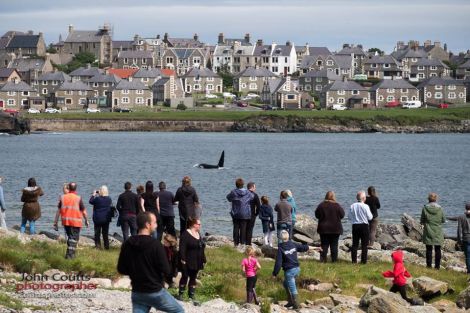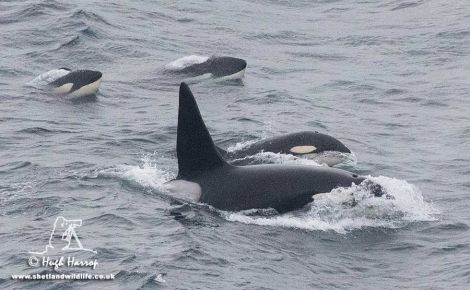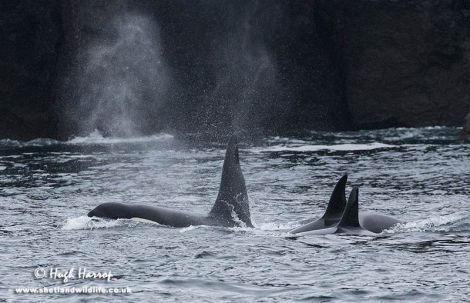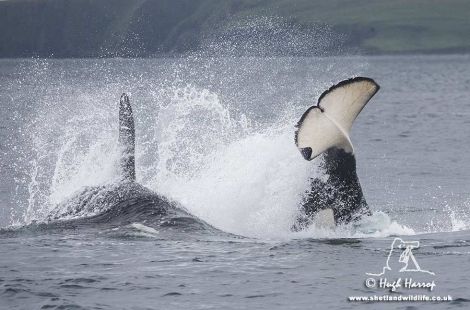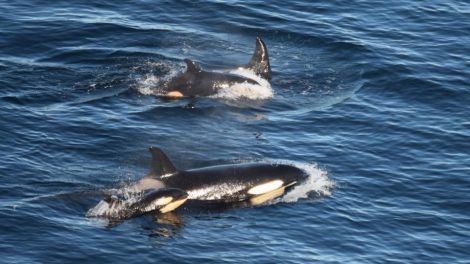News / Orca watchers have whale of a time
AS SHETLAND recovers from three days of orca fever, the ultimate expert on killer whales living in the North Atlantic said the two pods of ten animals seen in the isles recently were regular summer visitors to our shores.
Dr Andy Foote has been instrumental in setting up the North Atlantic Killer Whale ID (NAKID) project, which gathers knowledge on the movements and behaviour of individual animals.
Dr Foote, who now works on the genomics of killer whales at the University of Bern in Switzerland, said he could easily identify individual whales in photos taken over the last few days.
The predators have been watched by hundreds of delighted islanders and visitors over the last three days as the mammals came close in to hunt at Sumburgh, Gulberwick, Lerwick and South Nesting.
Tour operator Hugh Harrop of Shetland Wildlife said there was an “enigma” about killer whales that made them so attractive to watch, similar to other top of the food chain predators such as polar bears.
“We know very little about them and it is one of the ultimate animals to see in the wild,” he said.
“I think we can probably relate to them. It is easy to draw comparisons with intelligent creatures, but there are clearly a lot of differences in that man has, unfortunately, the overriding say in how orcas will live and, indeed, if the species survives.”
Dr Foote said that most of the groups of killer whales seen around Shetland return to the isles each summer.
“We also know that some groups are spending the winter in Iceland feeding on herring before moving back to the Northern Isles and Caithness in the summer,” he said.
During fieldwork in 2008 and 2009, Dr Foote, then a PhD student at Aberdeen University, spent summer months in Shetland compiling an ID database of the killer whales roaming these northern waters.
Become a member of Shetland News
And he confirmed that a photo of two orca calves in one pod, taken by Gina Rathbone on Tuesday at Sumburgh, was a most unusual sight.
“I can identify 32 or ‘Busta’, an adult male. When I was up doing fieldwork, this group consisted of five whales and was the group we encountered most frequently,” he said.
“When the whales were photographed again in 2011 they had a new calf with them. It looks as though the two calves are new and born in the last year or two.
“That is relatively rare, due to the small group sizes that are typical of killer whales in Scottish waters, and the fact that killer whales typically give birth just once every five years.”
Dr Foote said he was in the process of updating his orca catalogue with new photographs, and is asking Shetland News readers to send him high-resolution photos showing the markings of individual whales.
“The scars on the white ‘saddle patch’ change over time and the fins can acquire new nicks. So we need to update the catalogue to be able to continue to recognise these individuals,” he said.
His e-mail address is: FooteAD@gmail.com
Meanwhile more than 2,500 people have already joined a new Facebook site, Shetland Orca Sightings, or SOS, which has been created by the Shetland Wildlife team to let locals find out where killer whales can be seen.
Users are also encouraged to share their photos and experiences.
Visit the Shetland Wildlife Facebook page at www.facebook.com/shetlandwildlife/?fref=ts
Become a member of Shetland News
Shetland News is asking its many readers to consider paying for membership to get additional features and services: -
- Remove non-local ads;
- Bookmark posts to read later;
- Exclusive curated weekly newsletter;
- Hide membership messages;
- Comments open for discussion.
If you appreciate what we do and feel strongly about impartial local journalism, then please become a member of Shetland News by either making a single payment, or setting up a monthly, quarterly or yearly subscription.






